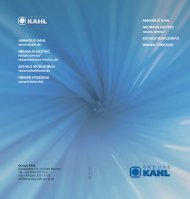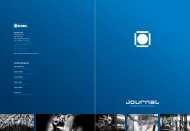Subsidiaries - Amandus Kahl Group
Subsidiaries - Amandus Kahl Group
Subsidiaries - Amandus Kahl Group
Create successful ePaper yourself
Turn your PDF publications into a flip-book with our unique Google optimized e-Paper software.
amandus kahl<br />
ASIA: COKE DUST PELLETS FOR STEEL SMELTING FURNACES<br />
The pellets are fed into blast furnaces for steel production.<br />
Acting as a service contractor of the major Asian steel man-<br />
ufacturer, our customer processes coke dust from the filters<br />
of coke lines. The coke dust is provided free of charge. The<br />
value of the pellets might correspond to that of coke which<br />
has varied between $ 190.00, and $ 680.00 in recent years.<br />
Our customer imports mainly coking coal for his own cok-<br />
ing plants, to a certain extent he also imports ready made<br />
coke. The aim is to reduce the coke import and to optimise<br />
his own coke production process in order improve the qual-<br />
ity of the produced coke. This includes a more efficient use<br />
of the dust produced in the coking plants. Four coke lines<br />
are in operation, each of which produces 1.2 million tons of<br />
coke per year. Approx. 120,000 tons of fines are produced<br />
per line. The fines collected in the filters of the coke lines<br />
are used as raw material for the pelleting lines. A fifth coke<br />
line is being built which is scheduled to be completed in<br />
2010.<br />
At present 3 pelleting lines equipped with pelleting presses<br />
type 39-1000 are in operation. Their throughput capacity<br />
is 5 – 6 t/h each. Pellets with a diameter of 4.5 mm are pro-<br />
duced. The first two presses were put into operation in April<br />
2008, the third one in July 2009. In the next 3 years another<br />
5 pelleting plants by <strong>Amandus</strong> <strong>Kahl</strong> are to be installed.<br />
Coke dust pellets meet two important goals. First, full-value<br />
coke is obtained and the dusts do not have to be sold below<br />
their value – after all, the dusts have caused high cost for raw<br />
material, transport and the coking process. Second, due to their<br />
homogeneity, the pellets have a defined sinking behaviour in<br />
the blast furnace, which improves the steel production process.<br />
Fig. 1 pelleting press type 39-1000<br />
Fig. 2 Empty fruit bunches (l.) and biomass pellets (/r.)<br />
Fig. 3 Crown expander<br />
1<br />
2<br />
3<br />
SUCCESS IN THE OIL PALM INDUSTRY –<br />
KAHL HAS TAKEN THE FIRST FLAT DIE PELLETING PRESS FOR<br />
PELLETS FROM EMPTY FRUIT BUNCHES INTO OPERATION<br />
The first flat die pelleting press for the production of biomass pellets from Empty Fruit Bunches has been put into operation in<br />
malaysia – the pelleting press 45-1250 with a drive power of 315 kW for a capacity of up to 5 t/h. The pellets are intended for exam-<br />
ple for energy production and for refinement into ethanol in the BTL process. With pelleting plants for oil palm fronds, <strong>Amandus</strong><br />
<strong>Kahl</strong> has already gained an excellent reputation in malaysia and regularly delivers pelleting presses to that country. EFBs have been<br />
the centre of interest of the biomass industry for some time as large quantities of EFBs are produced as a residue in palm oil mills,<br />
which means that they do not produce any transport costs for raw material supply. The largest producers of palm oil are malaysia<br />
and Indonesia. Palm oil is also produced in Africa, South America and other Southeast Asian countries.<br />
THE CROWN ExPANDER: PELLETING WITHOUT A PELLETING PRESS<br />
Our customers operate more than 600 expanders worldwide.<br />
In the u.S.A. for example, turkey fattening feed is expanded<br />
before pelleting in most cases. The annular gap expander has<br />
proved to be a good solution also in other fields such as starch<br />
modification or the oilseeds-processing industry. And last but<br />
not least, we have developed our <strong>Kahl</strong> extruder on the basis<br />
of the expander. With the extruder even higher mechanical<br />
energy inputs and modification degrees can be realised, and<br />
the products – fish feed, petfood, and snacks – can be pelleted<br />
or given other defined shapes. For quite some time, there has<br />
been a clear tendency towards coarse grinding of feed.<br />
<strong>Amandus</strong> <strong>Kahl</strong> remembered that in the annular gap expander,<br />
coarse grinding structures remain largely unchanged, although<br />
the product is exposed to a strong pressure and kneading effect.<br />
The pressure load in the expander acts on all sides of the<br />
coarse particles. The homogeneous pressure distribution on<br />
the entire particle circumference is supported by embedding<br />
these coarse particles in a pasty moist matrix of fine particles.<br />
Another advantage lies in the fact that the finer particles are<br />
agglomerated during expansion and thus are transformed into<br />
coarse structures. It occurred to our engineers that they might<br />
equip the expander outlet with an annular die similar to that of<br />
a pelleting press. A die without pan grinder rollers to be more<br />
precise, as they wondered: Should the high internal pressure<br />
of the expander not be able to press the finished product right<br />
through the round or oblong bores in the die ring, thus making<br />
the pressing and crushing effect of pan grinder rollers superfluous?<br />
– A rotating cutter was designed, meant to cut the product<br />
18/19<br />
strands leaving the die to uniform pellet lengths. So the »Crown<br />
Expander« was born. The machine owes its name to the crown<br />
form of the first dies which were provided with slits instead of<br />
bores.<br />
One important component of the annular gap expander remained<br />
unchanged in the Crown expander: The hydraulically<br />
moveable cone. This cone can be moved into and out of the<br />
crown die at the outlet end. Depending on the position of the<br />
cone in the die, more or less die bores are open for the production<br />
of pellets. Thus the pelleting process is easy to control by<br />
simply varying the cone position – in contrast to conventional<br />
extrusion processes which require die changes or far more<br />
complicated control mechanisms.<br />
The results obtained so far, have met every expectation, which<br />
means that we succeeded in the proverbial »squaring of the circle«:<br />
The Crown expander produces pellets or other regularly<br />
shaped structures while preserving coarse particles and simultaneously<br />
agglomerating fine and finest components. The positive<br />
nutritional effect of expansion is an additional advantage<br />
which traditional pelleting does not offer.<br />
The crown expander – an ideal example of a successful further<br />
development taking into account aspects of animal nutrition<br />
and process technology.











